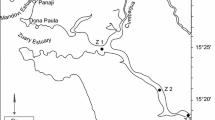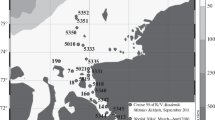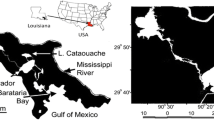Abstract
Grazing on planktonic bacteria by microzooplankton was estimated by separating bacteria from the larger plankton with 1μm pore Nuclepore filtration and measuring changes in bacteria in filtered and unfiltered samples over 24 hours. In the absence of grazers, bacteria increased linearly. The regression coefficient of linear increase was used to estimatein situ bacterial production. When grazers were present, the changes in bacteria concentration usually took the form of a linear decline, and grazing was estimated by subtracting the regression coefficient of the unfiltered sample from that of the 1μm filtrate. Results from the Essex estuary-coastal system of northern Massachusetts show grazing and production at rates that indicate a daily turnover of the standing crop of bacteria, with highest values in mid-estuarine waters. Experiments on the size distribution of grazing showed that microzooplankton from 1–3μm were responsible for most of the observed decrease in bacteria. It was suggested that the basic pattern of linear increase of the bacteria in the absence of grazing reflects density-dependent limitation by substrate present at the outset of the incubation and is indicative of a population that has been maintained around the mid-point of the logistic growth curve by grazing.
Similar content being viewed by others
References
Burney CM, Johnson KM, Sieburth JMcN (1981) Diel flux of dissolved carbohydrate in a salt marsh and a simulated estuarine ecosystem. Mar Biol 63:175–187
Caron DA, Davis PG, Madin LP, Sieburth JMcN (1982) Heterotrophic bacteria and bacterivorous protozoa in oceanic macroaggregates. Science 218:795–797
Christian RR, Hanson RB, Newell SY (1982) Comparison of methods for measurement of bacterial growth rates in mixed batch cultures. Appl Environ Microbiol 43:1160–1165
Fallon RD, Newell SY, Hopkinson CS (1983) Bacterial production in marine sediments: will cell-specific measures agree with whole-system metabolism? Mar Ecol Progr Ser 11:119–127
Fenchel T (1982a) Ecology of heterotrophic microflagellates. I. Some important forms and their functional morphology. Mar Ecol Progr Ser 8:211–223
Fenchel T (1982b) Ecology of heterotrophic microflagellates. II. Bioenergetics and growth. Mar Ecol Progr Ser 8:225–231
Fenchel T (1982c) Ecology of heterotrophic microflagellates. III. Adaptations to heterogeneous environments. Mar Ecol Progr Ser 9:25–33
Fenchel T (1982d) Ecology of heterotrophic microflagellates. IV. Quantitative occurrence and importance as bacterial consumers. Mar Ecol Progr Ser 9:35–42
Fuhrman JA, Azam F (1980) Bacterioplankton secondary production estimates for coastal waters of British Columbia, Antarctica, and California, Appl Environ Microbiol 39:1085–1095
Gak DS, Romanova EP, Romanenko VI, Sorokin YI (1972) Estimation of changes in number of bacteria in the isolated water samples. In: Sorokin YI, Kadota H (eds) Microbial production and decomposition in fresh waters. Blackwell Scientific Publications, Oxford, pp 78–82
Haas LW, Webb KL (1979) Nutritional mode of several non-pigmented microflagellates from York River Estuary, Virginia. J Exp Mar Biol Ecol 39:125–134
Hagstrom A, Larsson U, Horstedt P, Normark S (1979) Frequency of dividing cells, a new approach to the determination of bacterial growth rates in aquatic environments. Appl Environ Microbiol 37:805–812
Hobbie JE, Daley RJ, Jasper S (1977) Use of Nuclepore filters for counting bacteria by fluorescent microscopy. Appl Environ Microbiol 33:1225–1228
Hollibaugh JT, Fuhrman JA, Azam F (1980) Radioactively labeling of natural assemblages of bacterioplankton for use in trophic studies. Limnol Oceanogr 25:172–181
Karl DM (1979) Measurement of microbial activity and growth in the ocean by rates of stable ribonucleic acid synthesis. Appl Environ Microbiol 38:850–860
Kirchman D, Ducklow H, Mitchell R (1982) Estimates of bacterial growth from changes in uptake rates and biomass. Appl Environ Microbiol 44:1296–1307
Larsson U, Hagstrom A (1982) Fractionated phytoplankton primary production, exudate release and bacterial production in a Baltic eutrophication gradient. Mar Biol 67:57–70
Linley EAS, Newell RC (1981) Microheterotrophic communities associated with the degradation of kelp debris. Kieler Meeresforsch, Sonderh 5:345–355
Linley EAS, Newell RC, Bosma SA (1981) Heterotrophic utilisation of mucilage released during fragmentation of kelp (Eklonia maxima andLaminaria pallida). I. Development of microbial communities associated with the degradation of kelp mucilage. Mar Ecol Prog Ser 4:31–41
Newell RC, Lucas MI (1981) The quantitative significance of dissolved and particulate organic matter released during fragmentation of kelp in coastal waters. Kieler Meeresforsch, Sonderh 5:356–369
Newell RC, Lucas MI, Linley EAS (1981) Rate of degradation and efficiency of conversion of phytoplankton debris by marine microorganisms. Mar Ecol Prog Ser 6:123–136
Newell SY, Fallon RD (1982) Bacterial productivity in the water column and sediments of the Georgia (USA) coastal zone: estimates via direct counting and parallel measurement of thymidine incorporation. Microb Ecol 8:33–46
Palumbo AV, Ferguson RL (1978) Distribution of suspended bacteria in the Newport River Estuary, N.C. Est, Coastal and Shelf sci 7:521–529
Peterson BJ, Hobbie JE, Haney JF (1978) Daphnia grazing on natural bacteria. Limnol Oceanogr 23:1039–1044
Pirt SJ (1965) The maintenance energy of bacteria in growing cultures. Proc Roy Soc (London), Ser B 163:224–231
Romanova AP, Zonoff AI (1964) On the estimation of production of bacterial biomass in the water body. Doklady Acad sci USSR 155:194–197
Sherr BF, Sherr EB (1983) Enumeration of heterotrophic microprotozoa by epifluorescence microscopy. Est, Coastal and Shelf sci 16:1–7
Sherr BF, Sherr EB, Berman T (1983) Grazing, growth, and ammonium excretion rates of a heterotrophic microflagellate fed with four species of bacteria. Appl Environ Microbiol 45:1196–1201
Somville M, Billen G (1983) A method for determining exoproteolytic activity in natural waters. Limnol Oceanogr 28:190–193
Stuart V, Lucas MI, Newell RC (1981) Heterotrophic utilisation of particulate matter from the kelpLaminaria pallida. Mar Ecol Prog Ser 4:337–348
Stuart V, Newell RC, Lucas MI (1982) Conversion of kelp debris and faecal material from the musselAulacoma ater by marine microorganisms. Mar Ecol Prog Ser 7:47–57
Turner RE (1978) Community plankton respiration in a salt estuary and the importance of macrophytic leachates. Limnol Oceanogr 23:442–451
Vaatanen P (1980) Effects of environmental factors on microbial populations in brackish waters off the southern coast of Finland. Appl Environ Microbiol 40:48–54
Wetzel RG, Likens GE (1979) Limnological analyses. WB Saunders Co, Philadelphia
Williams FM (1980) On understanding predator-prey interactions. In: Ellwood DC, Hedger JN, Latham MJ, Lynch JM, Slater JH (eds) Contemporary microbial ecology. Academic Press, London, pp 349–375
Wright RT, Coffin RB (1983) Planktonic bacteria in estuaries and coastal waters of northern Massachusetts: spatial and temporal distribution. Mar Ecol Prog Ser 11:205–216
Wright RT, Coffin RB, Ersing CP, Pearson D (1982) Field and laboratory measurements of bivalve filtration of natural marine bacterioplankton. Limnol Oceanogr 27:91–98
Wright RT (in press) Dynamics of pools of dissolved organic carbon. In: Hobbie JE, Williams PJ (eds) Heterotrophy in the sea. Plenum Press, London
Wright RT, Coffin RB (in press) Factors affecting bacterioplankton density and productivity in salt marsh estuaries. In: Reddy CA, Klug MJ (eds) Current perspectives in microbial ecology. Am Soc for Microbiol, Wash., D.C.
Author information
Authors and Affiliations
Rights and permissions
About this article
Cite this article
Wright, R.T., Coffin, R.B. Measuring microzooplankton grazing on planktonic marine bacteria by its impact on bacterial production. Microb Ecol 10, 137–149 (1984). https://doi.org/10.1007/BF02011421
Issue Date:
DOI: https://doi.org/10.1007/BF02011421




